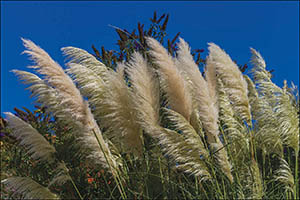
Ornamental grasses like elephant grass, add interest to an otherwise barren landscape in winter.
By Lin Johnson
Late winter is the perfect time to cut back ornamental grasses. When left to stand in the fall and early winter, ornamental grasses can provide great interest in the landscape. Although grasses can be cut back safely anytime from fall to late spring, allowing them to stand through most of the winter has advantages. The plumes and foliage add interest to an otherwise barren landscape and they provide cover for wildlife.
By February, most grasses look ragged. Cutting them back now allows you to clear the beds before the fronds and plumes scatter everywhere. It also allows light at the base of plants, letting new shoots sprout quickly. But most important, cutting back grasses while they are dormant gives you the opportunity to dig up oversize clumps to divide them.
Cutting grass calls for shears, a reciprocating saw, or electric hedge trimmers. Although grasses can be cut all the way to ground level, leaving a few inches above the ground is best. It not only keeps a bit of interest in the landscape but gives a nice base for the new shoots to have for support. It also insulates the roots and provides a bit of interest in the beds until spring.
So, get out in the landscape, cut back, divide and replant those grasses while you can!
Advanced Garland County Master Gardener, Lin Johnson, volunteers with GC Master Gardeners of the UofA Div. of Agriculture, Cooperative Ext. Service. Master Gardeners pool skills and resources to improve home horticulture, stimulate interest in plants and gardening, and encourage beautification. For more information, call 501-623-6841 or email adykes@uaex.edu. The University of Arkansas System Division of Agriculture is an equal opportunity/equal access/affirmative action institution.








